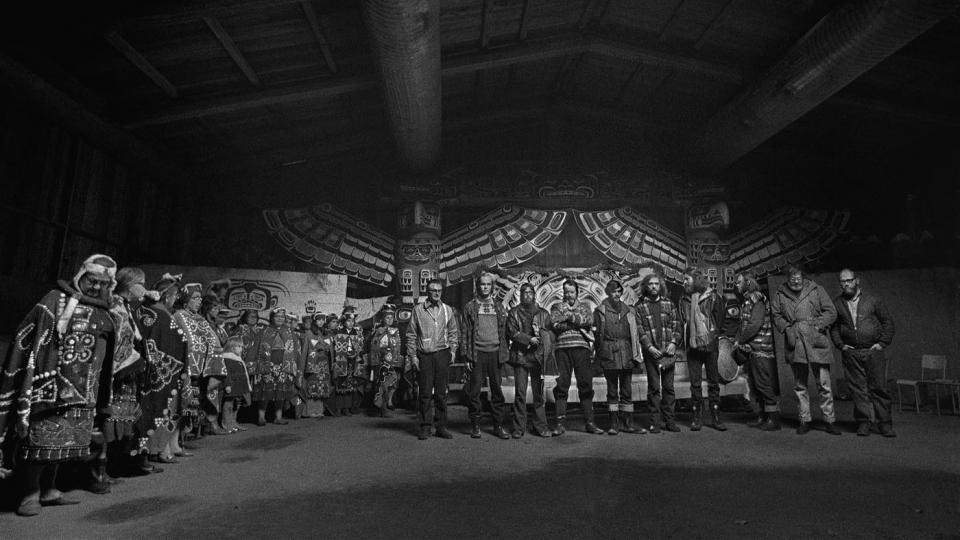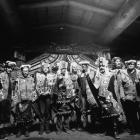The German branch of Greenpeace announced itself to the world in June 1981 when two activists climbed a smokestack in Hamburg and festooned it with a banner which read:
Erst wenn der letzte Baum gefällt, der letzte Fluss vergiftet und der letzte Fisch gefangen ist, werdet ihr merken, dass man Geld nicht essen kann. (In English: “When the last tree is cut down, the last fish eaten, and the last stream poisoned, you will realize that you cannot eat money.”)
—attributed to Cree Indian tribe
The activists attributed this warning to the Cree Indian tribe of North America, although like many such proverbs its provenance is dubious. Nevertheless, it fit well with Greenpeace’s conception of itself as the “Warriors of the Rainbow,” a phrase signifying solidarity with native peoples whose cultures were seen as much more environmentally responsible than those of industrialized nations.

The original “Rainbow Warriors” visit Kwakiutl Indians in their longhouse (1971)
The original “Rainbow Warriors” visit Kwakiutl Indians in their longhouse (1971)
All rights reserved © 1971 Greenpeace/Robert Keziere
The copyright holder reserves, or holds for their own use, all the rights provided by copyright law, such as distribution, performance, and creation of derivative works.
How did Greenpeace develop this affinity with Native Americans? The story begins in 1971 when the organization was embarking on its first campaign, an attempt to sail a boat from Vancouver into a restricted US nuclear testing area on Amchitka Island in the North Pacific. Bob Hunter, a countercultural journalist and one of the most influential early members of Greenpeace, brought with him a book called Warriors of the Rainbow, a compilation of native American prophecies and myths collected and interpreted by Vinson Brown, a prolific nature writer with a strong interest in native American culture, and William Willoya, an Alaskan Indian who visited dozens of tribes throughout the northwest in order to gather material for the book. A typical piece of sixties esoterica, the book added to the growing image of the wise “ecological Indian” that became such a powerful symbol of 1970s environmentalism, a construct that blended romanticized primitivism with moralistic environmentalism.
One of the central prophecies in Warriors of the Rainbow was the story of an old Indian grandmother named Eyes of Fire. When Eyes of Fire’s grandson asked why the “Grandfather in the sky” had allowed “the White Men to take our lands,” Eyes of Fire explained that it was all part of a greater cosmic plan. Initially, the Indians would be defeated and humbled by the white colonizers. In the long term, however, this would prove to be beneficial, for it was only through “the White Man’s conquest” that the Indians would be “cleansed of all selfish pride” and made ready for the “great awakening.” Then a spectacular rainbow would signify the arrival of a tribe of Rainbow Warriors that would “[spread] love and joy to others” and work toward “a new, spiritual civilization … [which] will create beauty by its very breath, turning the waters of rivers clear, building forests and parks where there are now deserts and slums, and bringing back the flowers to the hillsides.”

Greenpeace members are invited by the Kwakiutl tribe of British Columbia to a special tribal initiation ceremony
Greenpeace members are invited by the Kwakiutl tribe of British Columbia to a special tribal initiation ceremony
All rights reserved © 1971 Greenpeace/Robert Keziere
The copyright holder reserves, or holds for their own use, all the rights provided by copyright law, such as distribution, performance, and creation of derivative works.
Whether Willoya and Brown’s rendering of these legends was faithful to their original spirit is perhaps open to question. What is beyond doubt, however, is that much of Greenpeace’s association with Indian mythology came from Hunter’s reading of this book, an association that was strengthened when the Kwakiutl tribe of British Columbia invited Greenpeace members to participate in a tribal initiation ceremony, a privilege rarely granted to outsiders. While some of the older members of Greenpeace were skeptical, to Hunter and the other hippies the message was clear: Greenpeace was fated to be the messenger between the destructive White Man and the ecological Indians; it was, in short, the first tribe of Rainbow Warriors.
How to cite
Zelko, Frank. “Warriors of the Rainbow: The Birth of an Environmental Mythology.” Environment & Society Portal, Arcadia (2013), no. 16. Rachel Carson Center for Environment and Society. https://doi.org/10.5282/rcc/5625.
ISSN 2199-3408
Environment & Society Portal, Arcadia
 This work is licensed under a Creative Commons Attribution-NonCommercial-ShareAlike 3.0 Unported License.
This work is licensed under a Creative Commons Attribution-NonCommercial-ShareAlike 3.0 Unported License.
2013 Frank Zelko
This refers only to the text and does not include any image rights.
Please click on the images to view their individual rights status.
- Deloria, Philip J. Playing Indian. New Haven, CT: Yale University Press, 1998.
- Hunter, Robert. Warriors of the Rainbow: A Chronicle of the Greenpeace Movement. New York: Holt, Rinehart and Winston, 1979.
- Kaiser, Rudolf. “Chief Seattle’s Speeche(es): American Origins and European Reception." In Recovering the Word: Essays on Native American Literature, ed. Brian Swann and Arnold Krupat. Berkeley: University of California Press, 1987.
- Krech, Shepard, III. The Ecological Indian: Myth and History. New York: Norton, 1999.
- Willoya, William, and Vinson Brown. Warriors of the Rainbow: Strange and Prophetic Dreams of the Indians. Healdsburg, CA: Naturegraph, 1962.
- Zelko, Frank. Make it a Green Peace! The Rise of Countercultural Environmentalism. New York: Oxford University Press, 2013.








